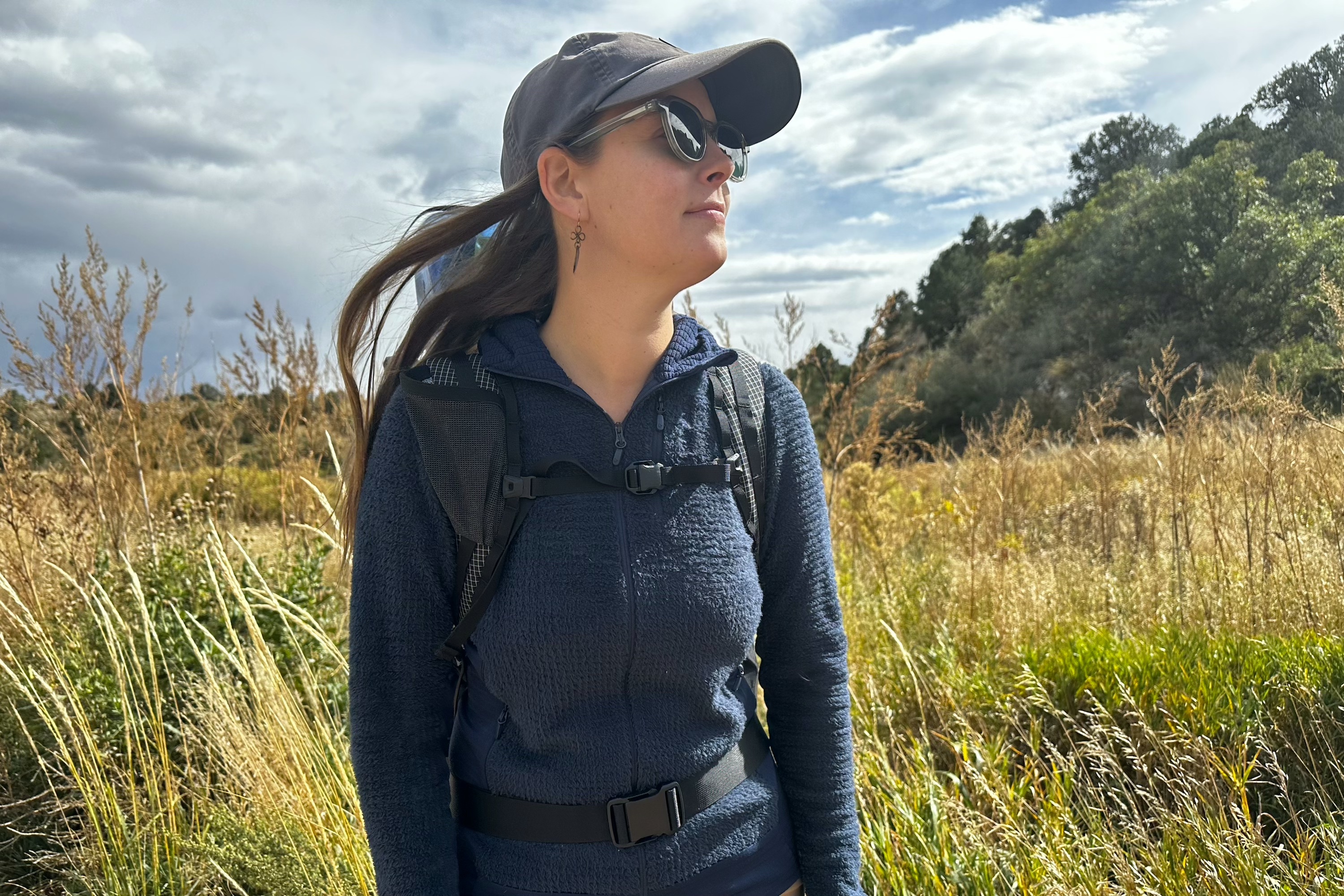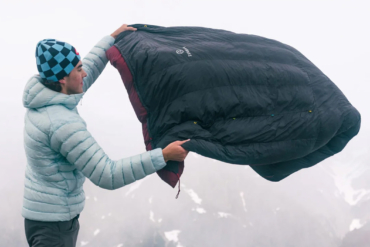Have you ever packed and repacked a dozen times, only to get on trail and have the weight not sit right? Have you carried a pack that was too big or too small? Or, have you felt so stiff in a hip belt that you couldn’t step over a log? How about finished a backpacking loop with the skin under your sternum strap rubbed raw? (I’ve had all of these experiences.)
My guess is, so have many women: It’s not uncommon to hear that packs are tricky or don’t fit well. That’s because they (usually) aren’t made for us.
And I don’t say this lightly but, that’s about to change.
In short: Simply put, have you been uncomfortable in pack options on market thus far? Symbiosis Gear wants to change that by serving women who hike with a pack “specifically designed for people with boobs.” So I was beyond stoked to get my hands on one of these yet-to-be-seen, mythical, perfect-for-women packs for testing. Because it turns out, ultralight packs (I’m looking at HMG and ZPacks) can definitely be improved when it comes to design, straps, and the overall fit for women.
“Women have been carrying heavy loads over long distances since the beginning of time,” founder Sarah Berkeley said. “So there has to be a way to do this [more comfortably].”
Enter The Aspen from Symbiosis Gear, which has done just that.
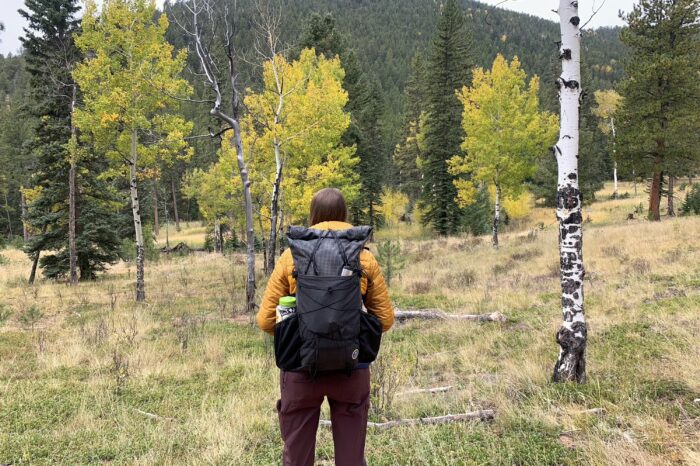
Before I dive into my testing, here’s a rundown of the pack components and how they’re designed with women’s bodies in mind:
- Minimalist, ultralight design (~38L pack)
- Boob-friendly S-curve straps (19-to 30.5-inch range)
- 3-way adjustable sternum strap for wider range of fit (17-inch range)
- Stowable waist belt (50-inch range)
- Easily accessible phone pocket
- Extra-large side pockets (with reinforced adjustable cord)
- And more
First-Look Review: Symbiosis Gear ‘The Aspen’ Pack
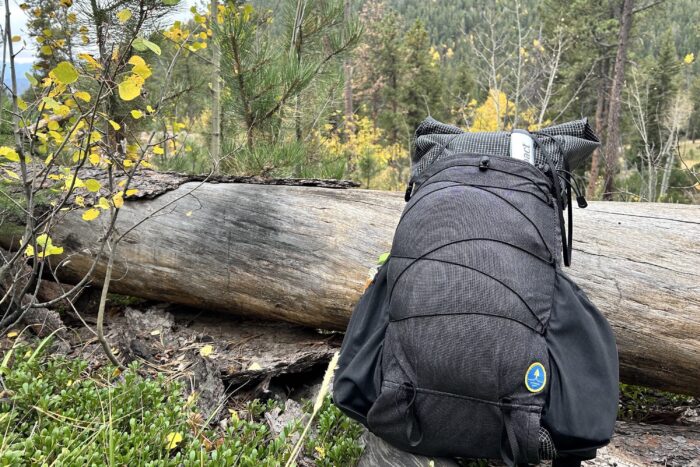
I had this pack for under 2 weeks in testing. Most of those days I was working, or at least, needed to be near a screen at some point. So, this first test wasn’t so much long thru-hiking, but instead quick overnights, early morning fast-packs, and day hikes. I logged about 18 miles with the pack with full weight (tent, sleep system, kitchen, food bag, layers, water filter, etc.), and another 3-4 miles with miscellaneous gear. I would estimate I tested the pack with 10-18 lbs of gear.
After putting down miles in a real trail test, I additionally loaded it up once more with a max weight of 20 pounds, and once more with a full bear can (BV450). Symbiosis Gear says it made sure to design the pack so a bear can would fit, but it’s “not recommended.” We did test to confirm that one fit comfortably along with other gear (but yeah, it was heavy and bulky).
Performance on Trail
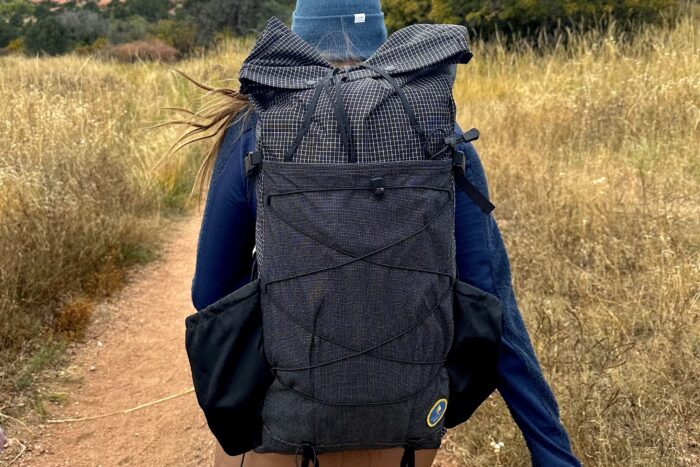
If you are familiar with ultralight thru-hiking packs from the likes of Hyperlite Mountain Gear, ULA, Granite Gear, and others, the Aspen Pack’s design will look familiar. However, most similarities stop at the exterior appearance.
Once I put the pack on, I did notice a lot of the components that Berkeley mentioned were tailored for women. This definitely includes the pack’s fit overall. In my opinion, it was the shoulder straps and the myriad adjustment points that really let this pack’s fit shine.
Beyond fit, I hiked with the Symbiosis Gear Aspen pack for 18-20 miles with my backpacking gear. The pack performed great on trail. I had zero issues with comfort on the straps, in the hip area, or maybe most importantly for women, across the chest and shoulders.
The pack truly fits and functions well. I was able to find the right adjustment points for me fairly quickly. Plus, it has so many functional compression straps and pockets, not to mention the rolltop, which allows lots of versatility with volume.
Specs & Materials
Almost the entire pack is made of 400-denier Extreema (a Dyneema fabric). The back pocket and bottom pocket are Spundura UHMWPE. Overall, the pack was highly durable and water-resistant.
This rolltop style of the pack was definitely a smart move for the pack’s intended use (ultralight/thru-hiking), and the Y-strap is a stellar and crucial part of the design. Moving down the pack, the grab handle, webbing loops, and webbing compression straps all worked well and held up to my testing on trail. Here, the compression straps stood out to me in testing — especially once I loaded up the side pockets with 1L bottles, and a set of collapsible trekking poles.
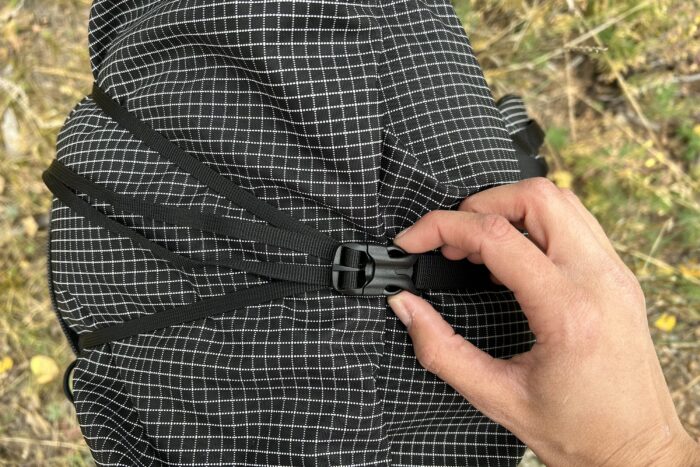
Finally, there’s a built in, burly Dyneema fabric stretch material phone pocket, as well as a stealth bottom pocket on the base of the pack — something I’ve never seen before but that did come in handy. Most commonly, I used it to stuff and stash a layer, but the size of the bottom pocket is perfect to slide in, say, a flat sit pad, or even a topo map as well (it fit these kinds of Nat Geo maps perfectly).
One area of improvement is the adjustable slide clip for the removable sternum strap — it clipped in and out easily on one side, but on the side with the phone pocket where there are four or five points of adjustment, it was really hard to physically slide out and remove due to the thicker and excess fabric.
The phone pocket functioned super well, was comfortable, and easy to access, and I know is a must for many backpackers and thru-hikers. So, I still appreciated that it was on the pack. That being said, the difficulty when I initially adjusted my sternum strap was definitely annoying. This is a small area where Symbiosis Gear could improve the Aspen.
Also, I found that there was way too much tail/excess webbing with the strap adjusted for my chest. But I know for many larger people or women with broader shoulders, having the full 17.5 inches of adjustment in the sternum will be really important to accommodate those who need a wider fit. This could be a pro or a con, depending on your size and stature.
Fit, Sizing, and Shape
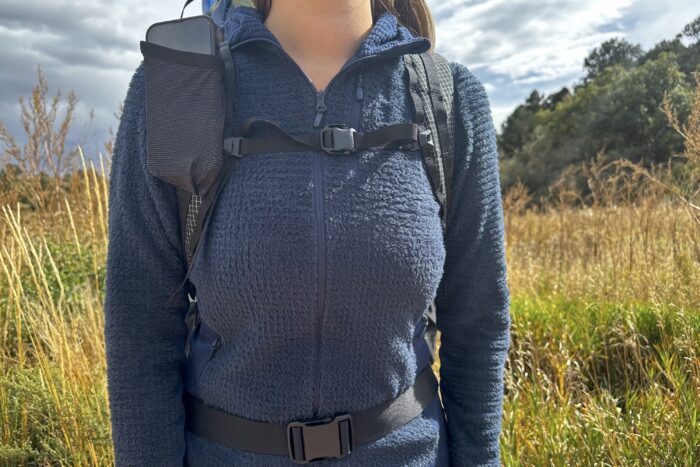
To say this pack fits nicely is an understatement. Compared to all other countless packs I’ve worn, the S-straps on this one actually seem to provide enough room in the chest area, while also being able to still strap down and secure and support.
Everything in the pack’s fit system: the shoulder straps shape and length, sternum strap, and hip belt all fit well. When I loaded it to its max weight (20 pounds), the pack sat nicely on my lower/mid back, without sagging down or digging into my hips.
Sure, have I been comfortable wearing other packs for 1-100 miles of backpacking? Yes. Were they perfect? No. Does this one feel different? Yes.
I know, I know — other women’s-specific packs on market use S-shaped straps. (Case in point: I don’t love the fit of women’s REI and Osprey packs I’ve tried, but have had success with my Deuter Aircontact Lite pack, and Big Agnes’ women’s-specific Sun Dog.) All that’s to say, S-straps aren’t the only thing that makes this pack, or any pack “for women.”
Other important fit features include the overall shape/width of the pack — where it sits after adjusted when you are carrying it — and secondly, the amount of adjustability. Far too many times, I’ve seen a sternum strap that offers no stretch, or isn’t wide enough for boobs. Or, even when fully cinched down tight, a pack with a torso length that’s too long, or shoulder straps that sit too wide.
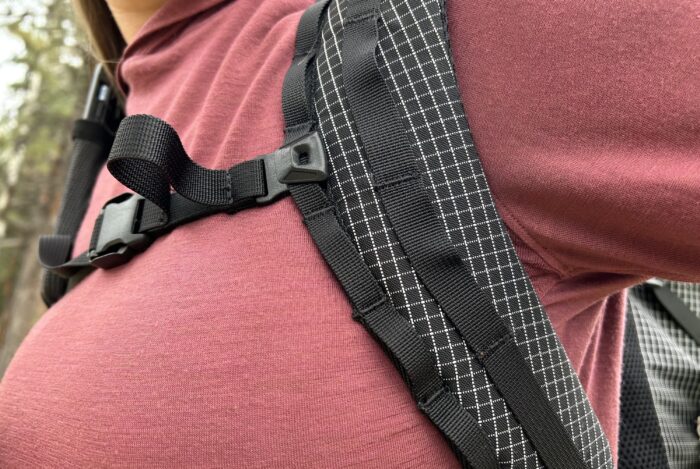
On the Aspen pack, daisy chains/webbing loops run down the full length — I mean every inch — of the S-straps. This means you can move the sternum strap up or down, and adjust the whole system a crazy amount in order to find the right fit. There’s also a tiny bit of elastic in the sternum strap itself for stretch and comfort.
And while the (again, widely adjustable) hip belt isn’t load-bearing, I found it comfortable even while carrying the max load of this pack. And yes, helpful for fit. If you are carrying 9-12 pounds versus 20, you probably don’t need the hip belt. And luckily, the belt can stash away so it’s not flopping about.
Conclusion on ‘The Aspen’ Pack
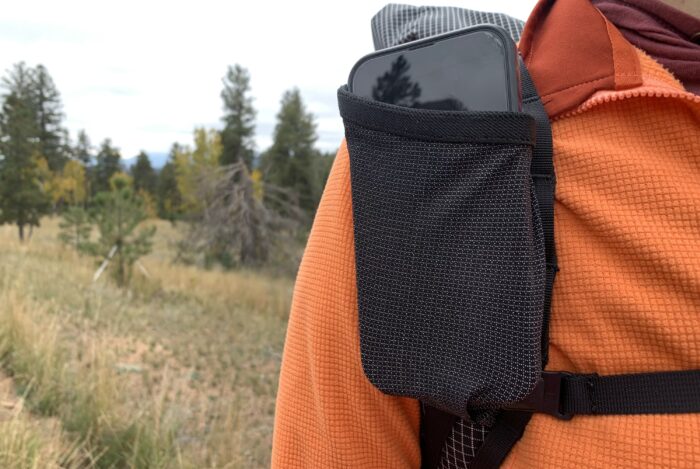
Here’s a question I got a bit hung up on with a few other friends: who is this pack for? Some brands try to be inclusive and say “everyone.” But no. In this case, I’m glad the target audience isn’t everyone under the sun. I’m glad I stumbled upon a piece of gear made for someone like me.
Symbiosis Gear is making this pack specifically for a certain group of people: people with boobs. Women. And yes, those who are capable of a fairly low base weight.
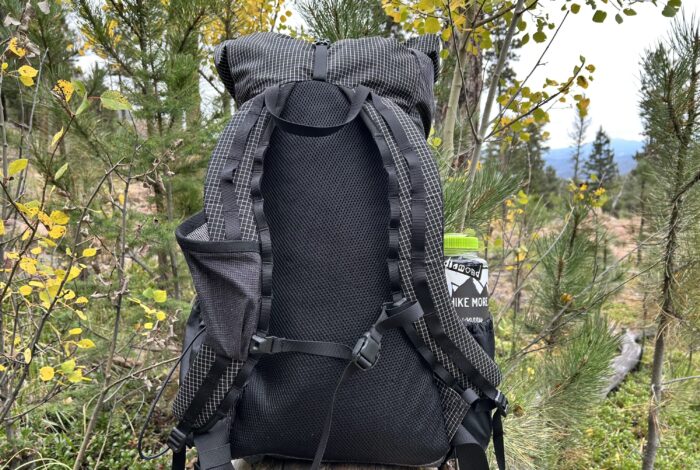
This pack seems perfect for thousands of women in the ultralight and thru-hiking communities. And hardcore backpackers and hikers as well. But what if you just backpack three or four times a year with some friends? Do you need an ultralight, thru-hiking friendly pack like this one?
Most people (including me) would say no, this pack isn’t designed for other types of trips. But if you are a woman of almost any height, size, and shape, the Aspen pack is still designed for you. That’s women who are 5’2″-5’10”, size A-DDD cup boobs (per Symbiosis Gear’s founder and fit testers). If you typically aim for 60-80L volume of pack space, this pack is going to be quite a different experience.
But I thought long and hard about it: I’m not an ultralight-thru hiker. I’m an above-average backpacker, and laidback section hiker (AT, CT, CDT). I carry all sorts of loads on all sorts of trails and terrain. Heck, I test gear for a living.
That being said, for most trips, I think I can manage a lower base weight that this pack would require. Over the years, my standard go-to backpacking kit (plus or minus a backpacking chair) has become dialed enough to classify as lightweight (~14 pounds). So absolutely, I think this pack could flex to work for different users.
Who Is This Pack For?
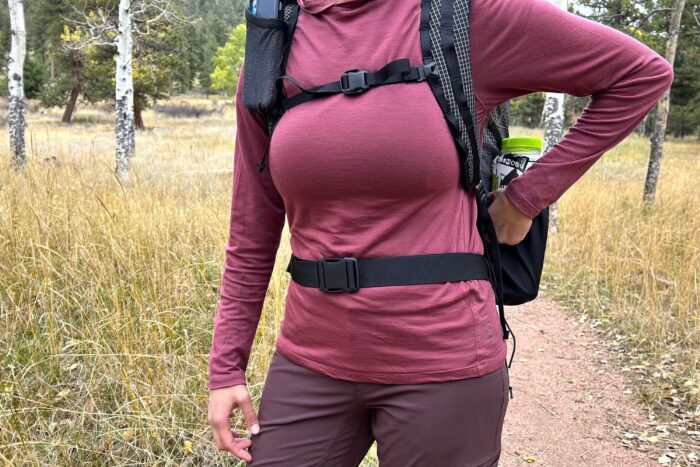
Symbiosis Gear’s tagline is a great one: this pack is tailor-made for people with boobs.
My verdict: Not just for ultralighters, the Aspen pack performed well in initial testing, and could be a great pack for a wide range of “people with boobs.” Only more time and testing will tell how this pack fares for plus-size women and for those taller than 5’10”, which looks like an area of improvement for Symbiosis. (For reference on our fit testing, I am 5’8″.) Otherwise, for women of all shapes and (chest) sizes, this pack rocks.
If other packs you’ve tried on as a woman have sucked, then thru-hiker or not, the Symbiosis Gear Aspen pack is worth a look.
The Symbiosis Gear Aspen Pack is currently available for preorder on Kickstarter through Oct. 31, 2023. The current preorder price is a reasonable and competitive $275 (compared to other ultralight packs on market).
